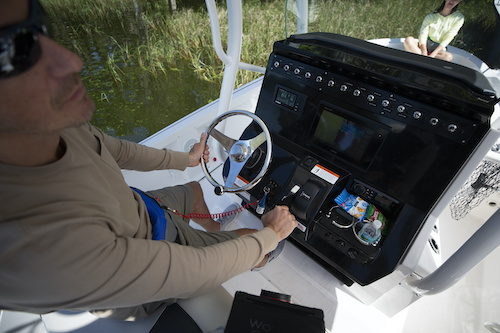Part of basic boating safety is using your boat’s engine cut-off switch, known as an “ECOS."
ECOS devices have been required equipment on boats since 2018, but most outboard-powered boats, personal watercraft (PWC), and many stern drive boats have been outfitted with them for decades.
They're especially crucial on small boats lacking enclosed cabins, where there's a risk of the captain being thrown away from the helm.
The Ultimate Boat Safety Guide
What is a Boat Engine Cut-Off Switch, or ECOS?
A standard engine cut-off switch is a small C-shaped clip attached to a spring-loaded button at the helm station, usually located in very close proximity to the ignition switch.
- The clip is attached to a lanyard, and the lanyard has a hook-clip on its far end.
- The captain of the boat uses this locking hook to secure the lanyard to his or herself.
- It can be clipped onto a stout ring on a life jacket or foul weather gear, a belt loop, or another secure article of clothing.
In case the boat captain leaves the helm for any reason, the lanyard initiates the disengagement of the C-clip from beneath the spring-loaded button. This action triggers the cut-off switch, promptly halting the engine. Thus, if the captain falls or steps away from the helm station, pulling the lanyard until it dislodges the C-clip ensures an immediate cessation of the boat's movement.
Additionally, digital ECOS switches are available, wearable as either a bracelet or on a lanyard. These devices interact with a helm-installed unit and activate through proximity. Some individuals favor these options as they offer freedom of movement around the boat without the constraints of a physical lanyard. It's important to consider, though, that they come at a higher cost compared to standard ECOS switches and typically necessitate professional custom installation.
Read Next: How to Be a Responsible Boat Captain
Why it's Important to Use a Boat Cut-Off Switch
If a large wave or impact ejects the captain from their seat and the boat continues running, this would be extremely dangerous.
Having an ECOS in place and using it properly means that the boat will shut down immediately following any such incident, reducing the potential for any additional danger.
Since April 2021, employing an ECOS has not only been wise but also a legal requirement. If your boat is equipped with an ECOS, it is imperative that you utilize it.
How to Drive & Operate a Personal Watercraft (PWC)
Do I Have to Wear My Boat's Engine Cut-off Switch Lanyard?
Mandatory use of an ECOS doesn’t apply to all boats. Here are the critical elements determining whether you must use one:
- Your boats was built with an ECOS system.
- Your boat is under 26 feet in length.
- The helm is not enclosed by a cabin.
- The power system provides 115 pounds of thrust (about three horsepower) or more.
- The boat is operating at or above planning speed.
If your boat checks all of these boxes, any time you advance the throttle enough to get on plane you need to be using the ECOS system. If you’re unsure if your boat planes see our Boat Hull Types, Shapes, and Design page, which includes an explanation of planning versus displacement hulls.
Remember that while this regulation is a federal law, many states already have ECOS laws and it’s always your responsibility as the captain to understand the local laws and regulations. You can find your state’s specific regulations by visiting the interactive map on our State Boating Laws, Rules, and Requirements page. You can also learn more about ECOS regulations by visiting the U.S. Coast Guard website.




